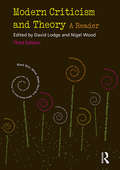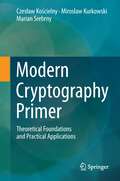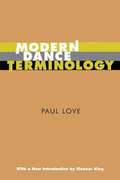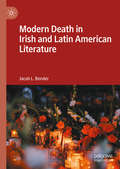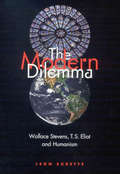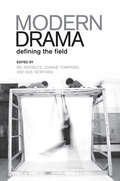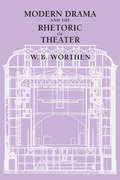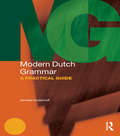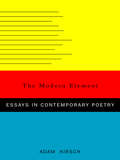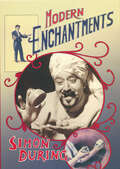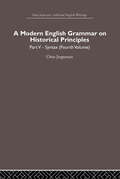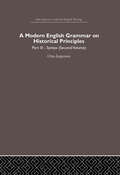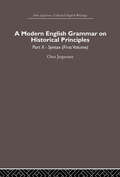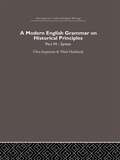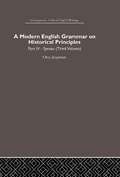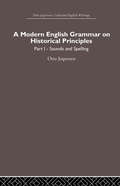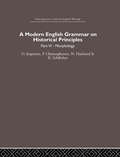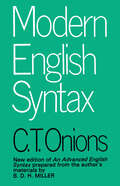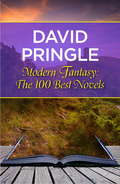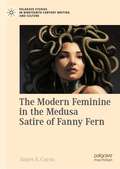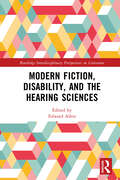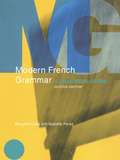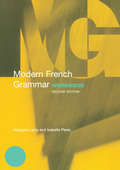- Table View
- List View
Modern Criticism and Theory: A Reader
by David Lodge Nigel WoodThis third edition of Modern Criticism and Theory represents a major expansion on its previous incarnations with some twenty five new pieces or essays included. This expansion has two principal purposes. Firstly, in keeping with the collection’s aim to reflect contemporary preoccupations, the reader has expanded forward to include such newly emergent considerations as ecocriticism and post-theory. Secondly, with the aim of presenting as broad an account of modern theory as possible, the reader expands backwards to to take in exemplary pieces by formative writers and thinkers of the late nineteenth and early twentieth centuries such as Marx, Freud and Virginia Woolf.. This radical expansion of content is prefaced by a wide-ranging introduction, which provides a rationale for the collection and demonstrates how connections can be made between competing theories and critical schools. The purpose of the collection remains that of introducing the reader to the guiding concepts of contemporary literary and cultural debate. It does so by presenting substantial extracts from seminal thinkers and surrounding them with the contextual materials necessary to a full understanding. Each selection has a headnote, which gives biographical details of the author and provides suggestions for further reading, and footnotes that help explain difficult references. The collection is ordered both historically and thematically and readers are encouraged to draw for themselves connections between essays and theories. Modern Criticism and Theory has long been regarded as a necessary collection. Now revised for the twenty first century it goes further and provides students and the general reader with a wide-ranging survey of the complex landscape of modern theory and a critical assessment of the way we think – and live – in the world today.
Modern Cryptography Primer
by Czesław Kościelny Mirosław Kurkowski Marian SrebrnyCryptography has experienced rapid development, with major advances recently in both secret and public key ciphers, cryptographic hash functions, cryptographic algorithms and multiparty protocols, including their software engineering correctness verification, and various methods of cryptanalysis. This textbook introduces the reader to these areas, offering an understanding of the essential, most important, and most interesting ideas, based on the authors' teaching and research experience. After introducing the basic mathematical and computational complexity concepts, and some historical context, including the story of Enigma, the authors explain symmetric and asymmetric cryptography, electronic signatures and hash functions, PGP systems, public key infrastructures, cryptographic protocols, and applications in network security. In each case the text presents the key technologies, algorithms, and protocols, along with methods of design and analysis, while the content is characterized by a visual style and all algorithms are presented in readable pseudocode or using simple graphics and diagrams. The book is suitable for undergraduate and graduate courses in computer science and engineering, particularly in the area of networking, and it is also a suitable reference text for self-study by practitioners and researchers. The authors assume only basic elementary mathematical experience, the text covers the foundational mathematics and computational complexity theory.
Modern Dance Terminology: The ABC's Of Modern Dance As Defined By Its Originators
by Paul LoveModern dance concepts, terms, principles, and movements are defined in the words of the great founders of modern dance.
Modern Death in Irish and Latin American Literature
by Jacob L. BenderThis comparative literature study explores how writers from across Ireland and Latin America have, both in parallel and in concert, deployed symbolic representations of the dead in their various anti-colonial projects. In contrast to the ghosts and revenants that haunt English and Anglo-American letters—where they are largely either monstrous horrors or illusory frauds—the dead in these Irish/Latinx archives can serve as potential allies, repositories of historical grievances, recorders of silenced voices, and disruptors of neocolonial discourse.
The Modern Dilemma
by Leon SuretteWhere Eliot's poetry is dominated by cultural, religious, and philosophical anxiety, Stevens' is bright, witty, and playful - and commonly dismissed as superficial. Surette demonstrates the seriousness of Stevens' life-long engagement with the modern dilemma of disbelief, showing that he, like Eliot, rejected the Humanist resolution. Surette proceeds by juxtaposing the two poets' responses in poetry and prose to the same texts and events: Marianne Moore's poetry, the Great War, Humanists and anti-Humanists, the Franco-Mexican Humanist Ramon Fernandez, Pure Poetry, and, finally, the gathering war clouds of the late 1930s.
The Modern Dilemma: Wallace Stevens, T.S. Eliot, and Humanism
by Leon SuretteWhere Eliot's poetry is dominated by cultural, religious, and philosophical anxiety, Stevens' is bright, witty, and playful - and commonly dismissed as superficial. Surette demonstrates the seriousness of Stevens' life-long engagement with the modern dilemma of disbelief, showing that he, like Eliot, rejected the Humanist resolution. Surette proceeds by juxtaposing the two poets' responses in poetry and prose to the same texts and events: Marianne Moore's poetry, the Great War, Humanists and anti-Humanists, the Franco-Mexican Humanist Ramon Fernandez, Pure Poetry, and, finally, the gathering war clouds of the late 1930s.
Modern Drama
by Joanne Elizabeth Tompkins Ric Knowles W. B. WorthenTheatre, like other subjects in the humanities, has recently undergone quintessential changes in theory, approach, and research. Modern Drama - a collection of twelve essays from leading theatre and drama scholars - investigates the contemporary meanings and the cultural and political resonances of the terms inherent in the concepts of 'modern' and 'drama,' delving into a range of theoretical questions on the history of modernism, modernity, postmodernism, and postmodernity as they have intersected with the shifting histories of drama, theatre, and performance. Using incisive analyses of both modern and postmodern plays, the contributors examine varied topics such as the analysis of periodicity; the articulation of social, political, and cultural production in theatre; the re-evaluation of texts, performances, and canons; and demonstrations of how interdisciplinarity inflects theatre and its practice.Including work by Sue-Ellen Case, Elin Diamond, Harry J. Elam Jr, Alan Filewod, Erika Fischer-Lichte, Stanton B. Garner Jr, Shannon Jackson, Loren Kruger, Josephine Lee, David Savran, Michael Sidnell, and Ann Wilson, the collection highlights the importance of continuing to investigate not only critical texts but also the terms of the debate themselves. Incorporating both drama history and modern studies, this compilation will be an invaluable work to all scholars of theatre and drama, and as well as those students of the humanities and modernism.
Modern Drama and the Rhetoric of theater
by W. B. WorthenThe history of drama is typically viewed as a series of inert "styles. " Tracing British and American stage drama from the 1880s onward, W. B. Worthen instead sees drama as the interplay of text, stage production, and audience. How are audiences manipulated? What makes drama meaningful? Worthen identifies three rhetorical strategies that distinguish an O'Neill play from a Yeats, or these two from a Brecht. Where realistic theater relies on the "natural" qualities of the stage scene, poetic theater uses the poet's word, the text, to control performance. Modern political theater, by contrast, openly places the audience at the center of its rhetorical designs, and the drama of the postwar period is shown to develop a range of post-Brechtian practices that make the audience the subject of the play. Worthen's book deserves the attention of any literary critic or serious theatergoer interested in the relationship between modern drama and the spectator.
Modern Dutch Grammar: A Practical Guide (Modern Grammars)
by Jenneke OosterhoffModern Dutch Grammar: A Practical Guide is an innovative reference guide to Dutch, combining traditional and function-based grammar in a single volume. With a strong emphasis on contemporary usage, all grammar points and functions are richly illustrated with examples. The Grammar is divided into two parts. Part I covers traditional grammatical categories such as nouns and verbs. Part II is carefully organized around language functions and contexts such as: Giving and seeking information Describing processes and results Expressing attitudes, mental states and emotions Registers and style Formal and informal communication, e.g. youth talk Main features of the Grammar include: Clear, succinct and jargon-free explanations Extensive cross-referencing between the different sections Emphasis on areas of particular difficulty for learners of Dutch This is the ideal reference grammar for learners of Dutch at all levels, from elementary to advanced; no prior knowledge of grammatical terminology is assumed and it provides indices of grammatical terms and functions. This Grammar is complemented by a companion website featuring related exercises and activities to reinforce learning.
The Modern Element: Essays on Contemporary Poetry
by Adam KirschA collection of bold, insightful, and controversial essays by "a poetry critic of the very first order" (New York Times). Over the last ten years, through essays in The New Republic, The New Yorker, and other magazines, Adam Kirsch--"one of the most promising young poet-critics in America" (Los Angeles Times)--has established himself among the most controversial and fearless critics writing today. Sure to cause heated debate, this collection of essays surveys the world of contemporary poetry with boldness and insight, whether Kirsch is scrutinizing the reputation of popular poets such as Billy Collins and Sharon Olds or admiring the achievement of writers as different as Derek Walcott, Czeslaw Milosz, and Frederick Seidel. For readers who want an introduction to the complex world of contemporary American poetry, from major figures like Jorie Graham to the most promising poets of the younger generation, Kirsch offers close readings and bold judgments. For readers who already know that world, The Modern Element will offer a surprising and thought-provoking new perspective.
Modern Enchantments: The Cultural Power of Secular Magic
by Simon During“A history of “secular,” or non-supernatural, or entertainment magic as an important but neglected constituent of modern culture” (Nicholas Daly).Magic, Simon During suggests, has helped shape modern culture. Devoted to this deceptively simple proposition, During’s superlative work, written over the course of a decade, gets at the aesthetic questions at the very heart of the study of culture. How can the most ordinary arts—and by “magic,” During means not the supernatural, but the special effects and conjurings of magic shows—affect people?Modern Enchantments takes us deeply into the history and workings of modern secular magic, from the legerdemain of Isaac Fawkes in 1720, to the return of real magic in nineteenth-century spiritualism, to the role of magic in the emergence of the cinema. Through the course of this history, During shows how magic performances have drawn together heterogeneous audiences, contributed to the molding of cultural hierarchies, and extended cultural technologies and media at key moments, sometimes introducing spectators into rationality and helping to disseminate skepticism and publicize scientific innovation. In a more revealing argument still, Modern Enchantments shows that magic entertainments have increased the sway of fictions in our culture and helped define modern society’s image of itself.Praise for ModernEnchantment“During documents the extent to which magic and magical thinking have pervaded, and continue to pervade, secular life . . . the author examines 19th- and 20th-century theatrical magic and “commercial conjuring” with great sensitivity to the social and cultural context in the Western world. Equally fascinating is the analysis of magic and early film.” —R. Sugarman, Choice“A richly informed, warmly argued addition to the growing number of books in which writers worry at the pervasive blurring of distinctions between act and appearance, organic consciousness and artificial intelligence, imagination and empirical experience, illusion and thought, reality TV and real life, dreams and money.” —Marina Warner, Financial Times“During moves confidently across three centuries of magic (and covers aspects of a few more besides). The sheer wealth of historical detail he provides is impressive, but no less impressive is the subtlety of his argumentation, and the suggestiveness of his claims . . . This extremely significant piece of work will appeal to literary critics, historians, and not least, devotees of magic.” —Nicholas Daly, author of Modernism, Romance, and the Fin de Siècle: Popular Fiction and British Culture, 1880–1914
A Modern English Grammar on Historical Principles: Volume 5, Syntax (fourth volume)
by Otto JespersenThis book was first published in 1954, A Modern English Grammar on Historical Principles is a valuable contribution to the field of English Language and Linguistics.
A Modern English Grammar on Historical Principles: Volume 3
by Otto JespersenThis book was first published in 1954, A Modern English Grammar on Historical Principles is a valuable contribution to the field of English Grammar and Linguistics.
A Modern English Grammar on Historical Principles: Volume 2, Syntax (first volume)
by Otto JespersenThis book was first published in 1954, A Modern English Grammar on Historical Principles is a valuable contribution to the field of English Language and Linguistics.
A Modern English Grammar on Historical Principles: Volume 7. Syntax
by Otto JespersenThis book is the seventh and last volume of that great work by Otto Jespersen the first volume of which was published in 1909. This volume looks at English Syntax including subjects such as sentence structure, word classes, word order, cases, comparison and determination.
A Modern English Grammar on Historical Principles: Volume 4. Syntax (third volume)
by Otto JespersenThis book was first published in 1954, A Modern English Grammar on Historical Principles is a valuable contribution to the field of English Language and Linguistics.
A Modern English Grammar on Historical Principles: Volume 1, Sounds and Spellings
by Otto JespersenThis book was first published in 1954, A Modern English Grammar on Historical Principles is a valuable contribution to the field of English Grammar and Linguistics.
A Modern English Grammar on Historical Principles: Volume 6
by Otto Jespersen Paul Christophersen Niels Haislund Knud SchibsbyeIn Morphology the first thing to be considered is the form, and second to that comes the use made of it, in Syntax the order is exactly the reverse, but it is essential that in both parts of the grammar form and use should be mentioned in every case. Volume 6 looks at English Morphology including subjects such as personal endings in verbs, tense formation in verbs, the naked word, compounds, change of vowels, suffixes, and the endings s, st and n, to name a few.
Modern English Literature: Modern
by G. H. MairThe intention of this book is to lay stress on ideas and tendencies that have to be learned by heart.
Modern English Syntax
by C.T. OnionsThis standard introductory textbook presents in systematic form an account of current English practice. The introduction provides a full scheme of sentence analysis. Part I contains a treatment of syntactical phenomena based on the analysis of sentences; Part II classifies the uses of forms. Cross-references indicate how the two parts supplement one another.
Modern Fantasy: The 100 Best Novels
by David PringlePringle presents his selections in chronological order and includes a synopsis of the story, a discussion of the author's overall contribution to fantasy literature, critical commentary on the title's significance, and a brief publishing history. An introductory essay tackles the difficulty of defining fantasy, while a "Brief Bibliography" directs readers to other discussions of the genre. By no means a definitive subject guide, this entertaining volume should serve as a solid introduction to the elusive field of imaginative literature.
The Modern Feminine in the Medusa Satire of Fanny Fern (Palgrave Studies in Nineteenth-Century Writing and Culture)
by James E. CaronThe Modern Feminine in the Medusa Satire of Fanny Fern argues that Sara Parton and her literary alter ego, Fanny Fern, occupy a star-power position within the antebellum literary marketplace dominated by women authors of sentimental fiction, writers Nathaniel Hawthorne (in)famously called “the damn mob of scribbling women.” The Fanny Fern persona represents a nineteenth-century woman voicing the modern feminine within a laughter-provoking bourgeois carnival, a forerunner of Hélène Cixous’s laughing Medusa figure and her theory about écriture féminine. By advancing an innovative theory about an Anglo-American aesthetic, comic belles lettres, Caron explains the comic nuances of Parton’s persona, capable of both an amiable and a caustic satire. The book traces Parton’s burgeoning celebrity, analyzes her satires on cultural expectations of gendered behavior, and provides a close look at her variegated comic style. The book then makes two first-order conclusions: Parton not only offers a unique profile for antebellum women comic writers, but her Fanny Fern persona also anchors a potential genealogy of women comic writers and activists, down to the present day, who could fit Kate Clinton’s concept of fumerism, a feminist style of humor that fumes, that embraces the comic power of a Medusa satire.
Modern Fiction, Disability, and the Hearing Sciences (Routledge Interdisciplinary Perspectives on Literature)
by Edward AllenThe relationship between critical disability studies and the hearing sciences is a dynamic one, and it’s changing still, both as clinicians come to terms with the evolving health of deaf and hearing communities and as the ‘social’ and ‘medical’ understandings of disability continue to gain traction among different groups. What might a ‘cultural’ approach to these overlapping areas of study involve? And what could narrative prose in particular have to tell us that other sources haven’t sensed?At a time when visual media otherwise seem to have captured the imagination, Modern Fiction, Disability, and the Hearing Sciences makes the case for a wide range of literature. In doing so – through serials, short stories, circadian fiction, narrative history, morality tales, whodunits, Bildungsromane, life-writing, the Great American Novel – the book reveals the diverse ways in which writers have plotted and voiced experiences of hearing, from the nineteenth century to the present day.
Modern French Grammar: A Practical Guide (Modern Grammars)
by Isabelle Perez Margaret LangThis new edition of the Modern French Grammar is an innovative reference guide to French, combining traditional and function-based grammar in a single volume. Divided into two parts, Part A covers traditional grammatical categories such as word order, nouns, verbs and adjectives and Part B is organized around language functions and notions such as: giving and seeking information describing processes and results expressing likes, dislikes and preferences. With a strong emphasis on contemporary usage, all grammar points and functions are richly illustrated with examples. Implementing feedback from users of the first edition of the Grammar, this second edition includes clearer explanations and greater emphasis on areas of particular difficulty for learners of French. This is the ideal reference grammar for learners of French at all levels, from beginner to advanced. No prior knowledge of grammatical terminology is assumed and a glossary of grammatical terms is provided. This Grammar is complemented by the Modern French Grammar Workbook Second Edition which features related exercises and activities.
Modern French Grammar Workbook (Modern Grammar Workbooks)
by Isabelle Perez Margaret LangModern French Grammar Workbook, second edition, is an innovative book of exercises and language tasks for all learners of French. The book is divided into two sections:* section 1 provides exercises based on essential grammatical structures* section 2 practises everyday functions (e.g. making introductions, apologizing, expressing needs).A comprehensive answer key at the back of the book enables you to check your progress. Taking into account feedback from the first edition, this second edition now features:* exercises graded on a 3-point scale according to their level of difficulty* cross-referencing to the Modern French Grammar, Second Edition, for each and every exercise* topical exercises that develop vocabulary.Modern French Grammar Workbook is ideal for all learners of French: beginners, intermediate and advanced students. It can be used both independently and alongside the Modern French Grammar (ISBN 0-415-33162-5).
